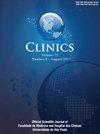Cost-effectiveness of selective laser trabeculoplasty as a replacement for hypotensive eye drops in the Brazilian public health system
IF 2.4
4区 医学
Q2 MEDICINE, GENERAL & INTERNAL
引用次数: 0
Abstract
Objective
This study aimed to determine the cost-effectiveness of selective laser trabeculoplasty (SLT) as a replacement for hypotensive eye drops in the Brazilian Unified Health System (SUS).
Methods
The authors conducted a cost-effectiveness economic assessment using data from a previously published prospective, non-randomized, single-arm interventional study. The costs were estimated from the perspective of the SUS, using data from the SIGTAP. The authors proposed a value of R$ 588.00 for bilateral SLT, based on the observed cost reduction with medications in the SLT group. Effectiveness was assessed as a reduction in intraocular pressure (IOP).
Results
The average annual cost of medications per patient was R$ 669.53 in the reference group (continuous use of eye drops) and R$ 80.62 in the intervention group (SLT). The average IOP reduction was 9.3 mmHg in the reference group and 9.8 mmHg in the intervention group. SLT proved to be a dominant strategy compared to the continuous use of eye drops, presenting a greater reduction in IOP and a lower total annual cost. The incremental cost-effectiveness ratio (ICER) was negative (-R$ 1.82), indicating that SLT is more effective and less costly.
Conclusions
SLT is a cost-effective alternative to hypotensive eye drops in the treatment of glaucoma in the SUS. The adoption of SLT can optimize resource allocation and improve clinical outcomes for patients with glaucoma. Implementing SLT at the proposed procedural cost optimizes spending by substantially reducing long-term medication costs and offering a sustainable alternative within the healthcare system.
选择性激光小梁成形术在巴西公共卫生系统中替代降压眼药水的成本效益
目的:本研究旨在确定选择性激光小梁成形术(SLT)作为巴西统一卫生系统(SUS)降压滴眼液替代品的成本效益。方法:作者使用先前发表的一项前瞻性、非随机、单臂介入研究的数据进行了成本-效果经济评估。使用SIGTAP的数据,从SUS的角度估计成本。基于观察到的SLT组药物成本降低,作者建议双侧SLT的价值为588.00雷亚尔。通过降低眼压(IOP)来评估有效性。结果参照组(连续滴眼液)患者年平均用药费用为669.53雷亚尔,干预组(SLT)患者年平均用药费用为80.62雷亚尔。对照组平均眼压降低9.3 mmHg,干预组平均眼压降低9.8 mmHg。与持续使用滴眼液相比,SLT被证明是一种主要的策略,其IOP降低幅度更大,年度总成本更低。增量成本-效果比(ICER)为负(-R$ 1.82),表明SLT更有效,成本更低。结论在美国青光眼治疗中,sslt是一种低成本的降压滴眼液替代方案。采用SLT可以优化资源配置,改善青光眼患者的临床预后。以拟议的程序成本实施SLT,通过大幅降低长期药物成本并在医疗保健系统内提供可持续的替代方案,优化了支出。
本文章由计算机程序翻译,如有差异,请以英文原文为准。
求助全文
约1分钟内获得全文
求助全文
来源期刊

Clinics
医学-医学:内科
CiteScore
4.10
自引率
3.70%
发文量
129
审稿时长
52 days
期刊介绍:
CLINICS is an electronic journal that publishes peer-reviewed articles in continuous flow, of interest to clinicians and researchers in the medical sciences. CLINICS complies with the policies of funding agencies which request or require deposition of the published articles that they fund into publicly available databases. CLINICS supports the position of the International Committee of Medical Journal Editors (ICMJE) on trial registration.
 求助内容:
求助内容: 应助结果提醒方式:
应助结果提醒方式:


